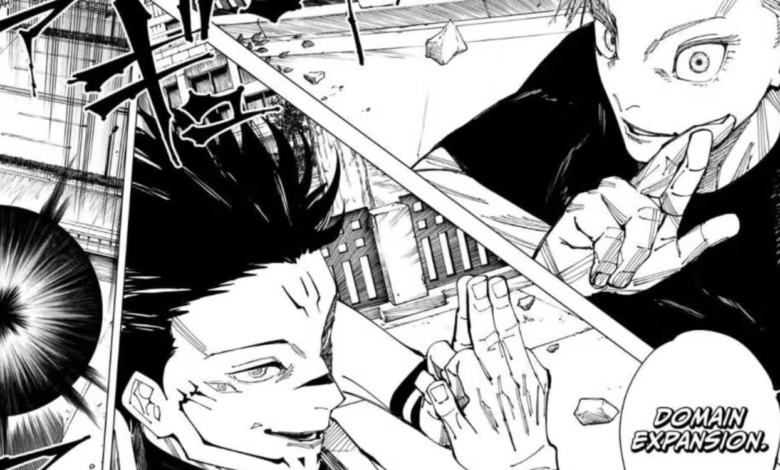JJK Manga Panels: A Deep Dive into the Art and Emotion of Jujutsu Kaisen

When it comes to breathtaking visuals, intense storytelling, and pure emotion captured in still images, few manga can match the brilliance of Jujutsu Kaisen. The JJK manga panels have captured hearts worldwide, not just for their striking art style but also for their ability to communicate complex emotions and explosive action with stunning precision. Whether you’re a seasoned manga reader or a newcomer drawn to the hype, understanding these panels can deepen your appreciation of what makes Jujutsu Kaisen a true masterpiece in modern manga.
The Power and Beauty of JJK Manga Panels
From the very first chapter, Jujutsu Kaisen established itself as a visually powerful series. The JJK manga panels blend dynamic action with emotional storytelling in a way that keeps readers on the edge of their seats. Every page feels alive — from the smooth flow of movement in battle scenes to the quiet tension in emotional moments.
Gege Akutami, the brilliant mind behind Jujutsu Kaisen, uses artistic precision and emotional intelligence to design panels that do more than show a fight; they tell a story. Each line, shadow, and expression carries meaning.
The Artistic Style Behind JJK Manga Panels
The artwork in Jujutsu Kaisen is gritty, raw, and detailed — a perfect reflection of the world it portrays. The JJK manga panels combine clean linework with intense shading and smart use of contrast to bring out the chaos and beauty of sorcery battles.
Here’s what makes the art style so remarkable:
- Expressive Faces: Characters’ emotions are amplified through subtle expressions — fear, rage, pain, or hope.
- Motion Lines: The action scenes feel fast and fluid because of how motion is depicted with sweeping lines and sharp angles.
- Panel Layouts: Akutami often breaks traditional panel structures, using diagonal divisions and overlapping scenes to heighten intensity.
- Shadow Play: Dark tones and heavy shadows emphasize the darker aspects of the JJK universe.
The end result? A visual rhythm that pulls readers into the story’s emotional and physical energy.
Storytelling Through JJK Manga Panels
The JJK manga panels don’t just display action — they tell stories. Every frame serves a purpose. Whether it’s Yuji’s determination, Megumi’s calm under pressure, or Gojo’s playful yet deadly confidence, Akutami’s panels are narrative tools that drive the plot forward.
Think of panels as “visual sentences.” In Jujutsu Kaisen, these sentences are composed with careful pacing and rhythm. For instance:
- Slow panels during quiet moments allow emotions to sink in.
- Tight, fragmented panels during battles create a sense of urgency and chaos.
- Wide panels showcase the scale of cursed techniques or emotional breakthroughs.
This storytelling structure gives the manga its cinematic quality, almost like watching a film unfold in your hands.
Iconic JJK Manga Panels That Defined the Series
Some JJK manga panels have become iconic, instantly recognizable across the anime and manga community. Let’s look at a few moments that define the series visually and emotionally:
| Scene | Description | Emotional Impact |
| Gojo’s Infinity Reveal | Gojo shows off his “Limitless” technique, creating infinite space. | Awe and admiration for his power. |
| Yuji vs. Mahito | The clash between humanity and curse. | Rage, empathy, and heartbreak. |
| Nobara’s Courageous Smile | Even in pain, Nobara smiles in defiance. | Inspiration and sorrow. |
| Sukuna’s Domain Expansion | A terrifying display of cursed energy and control. | Fear and fascination. |
| Toji’s Final Moment | The human side of a deadly sorcerer revealed. | Bittersweet emotion. |
Each of these panels demonstrates Akutami’s mastery of visual storytelling. The composition, timing, and emotion come together in unforgettable ways.
How JJK Manga Panels Capture Emotion
One of the most beautiful things about the JJK manga panels is their emotional depth. Akutami doesn’t shy away from showing pain, loss, and vulnerability — even amid the chaos of battle. The subtle lines under the eyes, the trembling hands, the fading light in someone’s expression — all tell a story words sometimes can’t.
Characters like Yuji Itadori are drawn with a mix of strength and sadness. Gojo Satoru’s confident smirk hides deep loneliness. Even villains like Mahito and Sukuna express twisted forms of joy and cruelty that reflect their distorted humanity.
This emotional layering makes Jujutsu Kaisen more than just a battle manga — it’s a deeply human experience told through powerful visual cues.
The Role of Shadows and Lighting in JJK Manga Panels
If there’s one visual element that stands out most in JJK manga panels, it’s how Gege Akutami plays with light and darkness. Lighting isn’t just an artistic choice — it’s a storytelling device.
- Bright lighting often symbolizes hope, revelation, or power.
- Dark shadows represent fear, corruption, or despair.
- Blended tones show moral conflict or uncertainty.
For example, in the Shibuya Incident arc, the heavy use of shadows mirrors the hopeless atmosphere of the story. Every flicker of light — like Gojo’s glowing eyes or Yuji’s determination — becomes a visual metaphor for resistance against despair.
JJK Manga Panels and Action Flow
One of the hardest things for any manga artist is capturing movement on a still page. But the JJK manga panels handle this flawlessly. The choreography of fights feels fluid and logical, even when techniques are supernatural or abstract.
The secret lies in panel sequencing — how one moment flows into the next. Akutami’s choice of angles, perspective, and pacing gives readers a sense of real motion.
You’ll often see:
- Diagonal lines to show speed and momentum.
- Zoomed-in frames for impact shots.
- Long sweeping panels for big explosions or cursed energy bursts.
This creates the illusion of animation within static art — a quality that makes the manga so thrilling to read even without sound or movement.
The Evolution of JJK Manga Panels Over Time
Since its debut, Jujutsu Kaisen has evolved significantly in terms of art style and panel composition. Early JJK manga panels were simpler and rougher, focusing more on storytelling than polish. But as Akutami gained experience, the artwork matured dramatically.
Early Chapters:
- Basic backgrounds and straightforward layouts.
- Focus on character introduction and worldbuilding.
Mid-Series (Shibuya Incident Arc):
- Complex choreography and dense panel arrangements.
- Improved anatomy and perspective accuracy.
- Greater emotional depth in character expressions.
Current Arcs:
- Refined linework and cinematic storytelling.
- Perfect balance between chaos and clarity.
This progression shows Akutami’s growth not only as an artist but also as a visual storyteller who understands the emotional weight of every stroke.
What Makes JJK Manga Panels Stand Out from Other Series
There are hundreds of shonen manga out there — Naruto, Bleach, One Piece, Chainsaw Man, you name it. So what makes the JJK manga panels stand out?
- Visual Realism: The art strikes a balance between stylized and realistic.
- Psychological Depth: Panels often reflect a character’s inner conflict.
- Unpredictable Layouts: Akutami experiments with non-linear storytelling.
- Balanced Aesthetics: Even during chaos, every detail feels intentional.
Unlike many manga that rely on flashy visuals alone, Jujutsu Kaisen merges action and emotion seamlessly. Each panel earns its place in the story — nothing feels wasted or filler.
The Influence of JJK Manga Panels on Anime Adaptation
When MAPPA adapted Jujutsu Kaisen into an anime, the JJK manga panels became blueprints for animation. Many of the show’s most stunning scenes — from Gojo’s Hollow Purple to Yuji’s fight with Mahito — were lifted directly from Akutami’s panels.
The animators didn’t just copy; they amplified the energy. The clean compositions and strong poses made the transition from paper to screen smooth and powerful. The manga’s visual clarity and cinematic angles set the foundation for one of the best-looking anime adaptations of all time.
Symbolism and Themes Hidden in JJK Manga Panels
Beyond their beauty, the JJK manga panels often hide layers of symbolism.
- Chains and bindings often symbolize fate and restraint.
- Broken objects represent shattered ideals or hope.
- Eyes and gaze direction hint at hidden emotions or motives.
Akutami’s panels reward careful readers. Every detail — a small gesture, a distant shadow, a character’s positioning — can add meaning to the story. It’s no wonder fans love to analyze each chapter frame by frame.
How Fans Connect Through JJK Manga Panels
Across social media, JJK manga panels are constantly shared, analyzed, and celebrated. Fans recreate them through digital art, tattoos, wallpapers, and edits. The emotional intensity and aesthetic appeal make them perfect for expressing fandom identity.
Fan communities often discuss:
- The symbolism in a specific panel.
- How Akutami uses contrast and angles.
- Which panel best represents each character’s essence.
It’s not just art — it’s a visual language that connects millions of readers worldwide.
Lessons from JJK Manga Panels for Aspiring Artists
For anyone interested in manga creation, the JJK manga panels are a goldmine of artistic lessons:
- Master panel pacing: Control rhythm and emotion with panel size and shape.
- Study body language: Show emotion through posture and motion.
- Use shadows creatively: Let lighting enhance mood and meaning.
- Keep flow readable: Even complex action should feel natural and easy to follow.
Gege Akutami’s work teaches that great manga art isn’t about perfection — it’s about communication. Every line should say something, and every panel should move the story forward.
Conclusion: The Legacy of JJK Manga Panels
In the grand world of manga, few works blend visual artistry and storytelling as flawlessly as Jujutsu Kaisen. The JJK manga panels stand as a testament to how emotion, chaos, and meaning can coexist within a single frame.
They’re not just drawings — they’re the heartbeat of the story, pulsing with energy, emotion, and soul. From the quiet pain in a character’s eyes to the explosive grandeur of cursed techniques, each panel invites readers to look deeper and feel stronger.
As the story continues to unfold, one thing’s certain: the JJK manga panels will keep setting new standards for what manga art can achieve — blending skill, passion, and imagination into visuals that stay with us long after we’ve turned the page.
You may also read
Introduction: Understanding What “White People Food” Really Means





